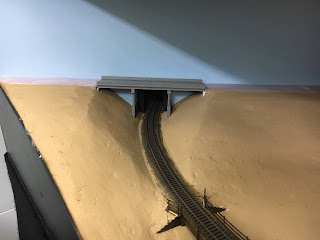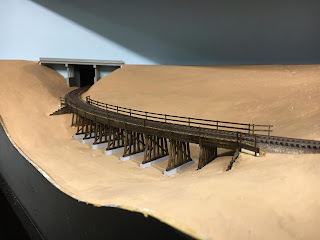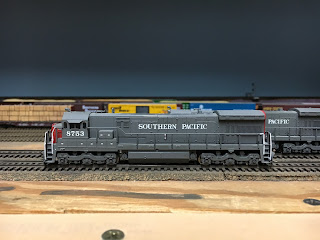Been awhile since updating the blog (18 months), due mainly to planned obsolescence of devices and job justification of platform interfaces (ha), but hopefully have things working again so I can again share pics and bits of recent layout progress.
One of the biggest stumbling blocks for the layout having a continuous operating scheme here (ending and restarting ops at any point), had been the large amount of woodchip car loadings. There are currently close to 40 chip cars on the layout moving between the paper mill, staging, and lumber mills. With all the non standard load sizes the chip cars required, it didnt seem very practical to utilize removable loads. Another issue was how to empty each of these cars without having to lift (or reposition) them from the layout, to avoid excessive handling. I had been restaging each car between sessions manually, which was a big pain anyway. I needed a way to load and unload the woodchips! After diving into the use of JMRI Ops, I knew I had to figure a way to make the fleet of chip cars have interchangeable loads. The idea of staging identical car numbers and using the program to swap loads and empties sounded ok, but trying to acquire a loaded and empty version of each car number now days is dismal with manufacturers today releasing only one limited run of models (too late now).
The solution was a magnetic chipload removal system, and a numbering scheme for each car and load that was still semi-interchangeable.
I glued a steel piece of 16 ga steel to the underside on one end of each chip load. A nominal sized ceramic magnet lifts the load readily as long as the load is not too tight fitting.
A block of pink foam was glued to the load to expedite loading, so that it would seat evenly and not fall too deep into the cars.
Since the load length was typical, but the width was not, I still had to number each car in a class to match loads numbered for multiple classes. This allows a variation of 4 different load types to fit multiple cars but mostly +/- one load tolerance size either way. I have a total of 6 load sizes (labeled as ABC, BCD, CDE, DEF), that fit those various car sizes. This system has proven to be fairly user friendly, and pretty reliable so far.
Cars move from industry via locals to yard, then via manifests to staging, and eventually reverse the process to destination for load exchange. There is always enough overlap between movements to allow the sessions to continue without loading/unloading interaction during ops.
Now we can run up to a full day of ops, and pick up where we left off with minimal interaction as compared to the restaging I had previously been saddled with.
With the visible car load plan now working smooth, I returned to updating my latest revision of JMRI Ops, which has already been refined multiple times over the last couple years, but is finally working pretty well. I put a printer under the layout to actively print out manifests for easy access to new paperwork. Trying to deal with a full keyboard and monitor around the layout is at times necessary, but not very user friendly, so am also remotely running the Ops program from iphone to the printer with VNC during sessions. This allows manifests / switchlists to be printed for crews and the yardmaster as the trains arrive and depart. Need to squeeze in a trial run utilizing the CATS program to notify JMRI that trains are arriving, so that the later will build trains automatically, with less me...
Lots of projects to get caught up on here in print, but if this posts well (already see some issues), I can resume postings again, or at least till technology gets ahead of me again.
:)
Happy RRing






































